Related Research Articles
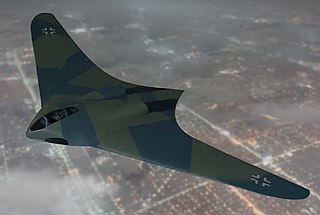
The Horten H.IX, RLM designation Ho 229 was a German prototype fighter/bomber designed by Reimar and Walter Horten to be built by Gothaer Waggonfabrik. Developed at a late stage of the Second World War, it was one of the first flying wing aircraft to be powered by jet engines.

The Focke-Wulf Fw 187 Falke ("Falcon") was a German aircraft designed in 1935. It was conceived by Kurt Tank as a twin-engine, high-performance fighter, but the Luftwaffe saw no role for the design, perceiving it as intermediate between the Messerschmitt Bf 109 and Bf 110. Later prototypes were adapted to two-seats to compete with the Bf 110 in the heavy fighter (Zerstörer) role, but only nine aircraft were built in total.
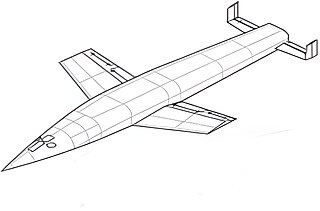
Silbervogel was a design for a liquid-propellant rocket-powered sub-orbital bomber produced by Eugen Sänger and Irene Bredt in the late 1930s for The Third Reich. It is also known as the RaBo. It was one of a number of designs considered for the Amerikabomber project, which started in the spring of 1942, being focused solely on trans-Atlantic-range piston-engined strategic bombers such as the Messerschmitt Me 264 and the Junkers Ju 390, the only two airframe types which were actually built and flown for the competition. When Walter Dornberger attempted to create interest in military spaceplanes in the United States after World War II he chose the more diplomatic term antipodal bomber.

The Messerschmitt Me 263 Scholle (plaice) was a rocket-powered fighter aircraft developed from the Me 163 Komet towards the end of World War II. Three prototypes were built but never flown under their own power as the rapidly deteriorating military situation in Germany prevented the completion of the test program.

The Junkers Ju 287 was a multi-engine tactical jet bomber built in Nazi Germany in 1944. It featured a novel forward-swept wing, and the first two prototypes were among the very few jet propelled aircraft ever built with fixed landing gear.

The Focke-Wulf Fw 191 was a prototype German bomber of World War II, as the Focke-Wulf firm's entry for the Bomber B advanced medium bomber design competition. Two versions were intended to be produced, a twin-engine version using the Junkers Jumo 222 engine and a four-engine variant which was to have used the smaller Daimler-Benz DB 605 engine. The project was eventually abandoned due to technical difficulties with the engines.

Wunderwaffe is a German word meaning "wonder-weapon" and was a term assigned during World War II by Nazi Germany's propaganda ministry to some revolutionary "superweapons". Most of these weapons however remained prototypes, which either never reached the combat theater, or if they did, were too late or in too insignificant numbers to have a military effect. The V-weapons, which were developed earlier and saw considerable deployment, especially against London and Antwerp, trace back to the same pool of highly inventive armament concepts. In the German language, the term Wunderwaffe now generally refers to a universal solution which solves all problems related to a particular issue, mostly used ironically for its illusionary nature.

The Messerschmitt P.1101 was a single-seat, single-jet fighter project of World War II, developed as part of the 15 July 1944 Emergency Fighter Program which sought a second generation of jet fighters for the Third Reich. A prominent feature of the P.1101 prototype was that the sweep angle of the wings could be changed before flight, a feature further developed in later variable-sweep aircraft such as the Bell X-5 and Grumman XF10F Jaguar.
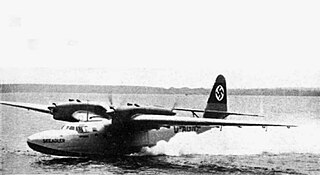
The Dornier Do 26 was an all-metal gull-winged flying boat produced before and during World War II by Dornier Flugzeugwerke of Germany. It was operated by a crew of four and was intended, in civilian service, to carry a payload of 500 kg (1,100 lb) or four passengers on the Lisbon to New York route. In military service it carried as many as eighteen passengers.
The Škoda-Kauba Sk 257 was a Czechoslovakian-built fighter trainer monoplane built by Škoda-Kauba Flugzeugbau for the Luftwaffe.

The Blohm & Voss P.208 was a design project for a tailless swept-wing propeller-powered interceptor designed by the German company Blohm & Voss towards the end of the Second World War.

The Škoda-Kauba SK P14 was a ramjet-powered emergency fighter project for the Luftwaffe. It was designed by the Škoda-Kauba industries towards the end of World War II as part of the Third Reich defense effort against the devastating allied bombing raids.
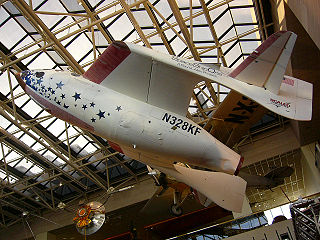
An outboard tail is a type of aircraft tail or empennage which is split in two, with each half mounted on a short boom just behind and outboard of each wing tip. It comprises outboard horizontal stabilizers (OHS) and may or may not include additional boom-mounted vertical stabilizers (fins). OHS designs are sometimes described as a form of tailless aircraft.
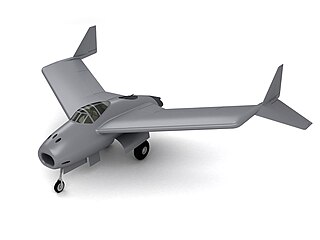
The Blohm & Voss P215 was an advanced jet night fighter project by Blohm & Voss during the Second World War. With a crew of three and twin jet engines, it featured a tailless swept-wing layout and heavy armament. An order for three prototypes was received just weeks before the war ended.
Otto Kauba (1908-1962) was an Austrian engineer who designed aircraft in the period during and after World War II. He also designed motor scooters in the postwar period.

The Messerschmitt Me 262 was a German World War II fighter aircraft built by Messerschmitt in the later stages of the war, and under license by Avia post-war.
References
Notes
Bibliography
- Nowarra, Heinz J. (1993). Die Deutsche Luftrüstung 1933–1945 Vol.4 – Flugzeugtypen MIAG-Zeppelin. Koblenz: Bernard & Graefe Verlag. ISBN 3-7637-5468-7.
- Saffek, Otta and Plocek, Pierre; "Les Étranges Créations d'Otto Kauba", Le Fana de l'Aviation, No.272, July 1992, pp. 14–22. (French)
- Titz, Zdenek and Zazvonil, Jaroslav; "Kauba's Dwarfs", Flying Review International, November 1965, pp. 169–172.